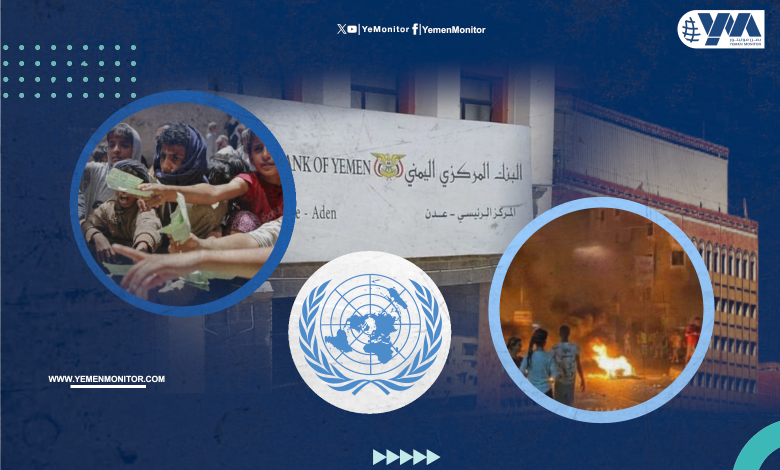Potential Impacts of the Recent Central Bank Crisis on Yemeni Households

Yemen Monitor/Sana’a/Exclusive:
The various directives issued by the central banks in Aden and Sana’a, which have led to noticeable disruptions in the financial and banking sectors, have escalated into a significant increase in retaliatory financial measures that are affecting the lives of Yemeni households and the country’s already collapsing economy, according to a new report issued on Sunday by the United Nations.
A recent report by the Food and Agriculture Organization of the United Nations (FAO), which Yemen Monitor has reviewed, states that there are economic and financial repercussions of what it described as retaliatory measures “between the Yemeni government and the authorities in Sana’a (Houthis) reached its peak in March 2024 after each side issued reciprocal regulatory measures against financial sector, culminating in the blacklisting of banks, the national currency, and other things.”
The report published the potential impacts as follows:
– Accelerated depreciation of the local currency: In the past year until June 2024, the Yemeni riyal in the Yemeni government areas lost its value against the US dollar by 38 percent, equivalent to an average monthly decline of 3 percent. The Yemeni riyal is expected to depreciate further at a much faster rate in the Yemeni government areas, by at least 5 percent per month over the next four months. The trajectory of the Yemeni riyal in the Houthi areas remains uncertain in the short term due to tight controls on exchange rates.
– Increased food and fuel price risks: The minimum food basket is expected to reach between $87 and $107 in August 2024, an increase of at least 6% in the Yemeni government areas at a time when casual labor rates are not expected to grow alongside an increase in the minimum cost of living. Similarly, the expected depreciation of the currency in the Yemeni government areas poses an increasing risk of rising diesel prices. As a result, this is expected to lead to higher food prices due to transportation costs, which account for about 30 percent of food price inflation. Food and fuel price risks in the Houthi areas remain unpredictable due to economically unresponsive price controls, but inflationary risks persist. This comes at a time when humanitarian aid has declined.
– Declining food and fuel imports: The inability of traders and importers to access sufficient dollars, transfer funds, and secure credit lines, coupled with currency depreciation and rising transaction costs, is expected to slow down commercial import flows, disproportionately affecting southern ports.
– Slowdown in domestic and foreign remittance flows: Remittances, which exceed $4.2 billion annually, play a critical role in meeting the food needs of millions of people in Yemen, equivalent to an average of $270 per month per household for 27 percent of the population who receive remittances. Financial sector disruptions are expected to further reduce already declining domestic and foreign remittance flows since 2022, leading to an accelerated depreciation of the currency, widening the import financing gap, and exacerbating household food insecurity.
– Exacerbated economic contraction: The ensuing financial sector crisis is expected to further hinder the Yemeni economy amid a delay in reaching a peaceful settlement. The International Monetary Fund had projected negative growth for the second year in a row in 2024. The worsening economic crisis is likely to negatively impact economic and commercial activities, increase unemployment rates, and reduce household incomes.
The report, which Yemen Monitor has reviewed, states that Yemen relies heavily on basic food from the market, with households allocating more than 65% of their income to food expenses. With a large proportion of the population (82%) living in multidimensional poverty and heavily reliant on market resources, coupled with the continuous decline in real income, households are increasingly at risk due to the currency crisis, the depreciation of the Yemeni riyal, and consequently rising food costs. This situation leaves them vulnerable to economic and market instability, and many households resort to food borrowing and assistance for support. This reliance may hinder their financial recovery, worsen their nutritional status, and deepen their poverty.




